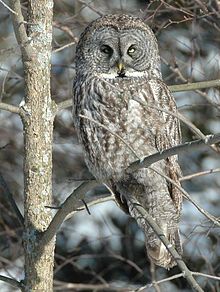Great grey owl
| Great grey owl | |
|---|---|
 |
|
| Whitby, Ontario, Canada | |
| Scientific classification | |
| Kingdom: | Animalia |
| Phylum: | Chordata |
| Class: | Aves |
| Order: | Strigiformes |
| Family: | Strigidae |
| Genus: | Strix |
| Species: | S. nebulosa |
| Binomial name | |
|
Strix nebulosa Forster, 1772 |
|
 |
|
| World distribution of S. nebulosa | |
The great grey owl or great gray owl (Strix nebulosa) is a very large owl, documented as the world's largest species of owl by length. It is distributed across the Northern Hemisphere, and it is the only species in the Strix (genus) found in both Eastern and Western Hemispheres. In some areas it is also called Phantom of the North, cinereous owl, spectral owl, Lapland owl, spruce owl, bearded owl, and sooty owl.
Adults have a large rounded head with a grey face and yellow eyes with darker circles around them. The underparts are light with dark streaks; the upper parts are grey with pale bars. This owl does not have ear tufts and has the largest facial disc of any raptor. There is a white collar or "bow tie" just below the beak. The long tail tapers to a rounded end.
In terms of length, the great grey owl is believed to exceed the Eurasian eagle-owl and the Blakiston's fish owl as the world's largest owl. The great grey is outweighed by those two species as well as several others, including most of the Bubo genus. Much of its size is deceptive, since this species' fluffy feathers, large head and the longest tail of any extant owl obscure a body lighter than that of most other large owls. The length ranges from 61 to 84 cm (24 to 33 in), averaging 72 cm (28 in) for females and 67 cm (26 in) for males. The wingspan can exceed 152 cm (5 ft 0 in), but averages 142 cm (4 ft 8 in) for females and 140 cm (4 ft 7 in) for males. The adult weight ranges from 580 to 1,900 g (1.28 to 4.19 lb), averaging 1,290 g (2.84 lb) for females and 1,000 g (2.2 lb) for males. The males are usually smaller than females, as with most owl species.
There are two recognized races of the great grey owl spread across North America and Eurasia.
In northern areas their breeding habitat is often the dense coniferous forests of the taiga, near open areas, such as meadows or bogs. In Oregon and California this owl has been found nesting in mixed oak woodlands. Once believed to require a cold climate, it is now known that this bird survives in a few areas where summer temperatures regularly exceed 100 °F (38 °C).
They breed in North America from as far east as Quebec to the Pacific coast and Alaska, and from Finland and Estonia across northern Asia. They are permanent residents, although northerly populations may move south and southeast when food is scarce. In Europe they are found breeding in Norway and Sweden and more numerously through Finland and Russia. Even though the species occurs in Europe, the first great grey owl recognized by science was found in Canada in the late 18th century.
...
Wikipedia

